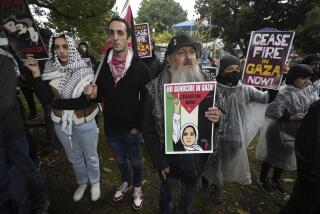To Manzanar : Pilgrimage: The trip back to the Mojave Desert internment camp for Japanese-Americans during World War II rekindles memories of loss and injustice.
MANZANAR, Calif. — On the bus ride to the site of the former desert internment camp where he spent three years of his childhood, Takatow Matsuno furled and unfurled a copy of a 46-year-old photograph.
It was a portrait of 77 Japanese-American children, among them Matsuno and his siblings, who spent most of World War II in an orphanage behind barbed wire at the Manzanar War Relocation Center in the eastern Mojave Desert.
“The FBI took my father away and my mother was in the hospital,” Matsuno explained. He was then 6 years old.
On the 22nd annual pilgrimage of Japanese-Americans back to Manzanar Saturday, Matsuno was trying to find the other faces in his photograph. And for Matsuno and some of the 300 former camp inmates and relatives who made the trek from Los Angeles, there was even more important unfinished business.
Matsuno, 56, has yet to receive his letter of apology from President Bush or the $20,000 reparation check that a 1988 law promises surviving internees. The first payments were handed out to centenarians at a ceremony last October. But to date, only those 71 and older have received payment, with those older than 62 awaiting their checks next year, and all survivors to be paid within three years.
“It doesn’t matter,” Matsuno said. “We should have gotten it when we got out of camp. That’s when we needed it.”
After the Japanese attack on Pearl Harbor in 1941, about 112,000 people of Japanese ancestry were rounded up and sent to 10 hastily built internment camps across the Western United States.
Manzanar--which means “apple orchard” in Spanish--was the first camp to open and housed 10,000 people in Army-style barracks, surrounded by barbed wire and guarded by military police. Two-thirds of them were American citizens.
Despite the impatience with the government’s delivery of reparation checks, some of those who made the trek Saturday said the belated U. S. apology has helped ease the bitterness, the bad memories, and the sense of betrayal--but not the need to ensure that future generations remember what happened on this windy, barren site.
“I think it has healed quite a few of the wounds,” said George Kiriyama, 59, principal of the Garden Community Adult School, who was making the trek back to Manzanar for the fifth time--this time with a delegation of teachers in tow.
“When we finally received our apology and received our reparations, many people felt, ‘Well, it’s about time,’ ” Kiriyama said.
“There are some that will be bitter until they die,” he said. “My mother-in-law has said she will never come back here and she never has. She says: ‘Why should I come back to a place that made me miserable?’ My father, he pased away some time ago, and he was never compensated.”
His mother, 101-year-old Sugi Kiriyama, was one of the first to receive her check from the President last October. “The reparations has compensated somewhat,” her son said. “Not totally, but somewhat.”
Nevertheless, Kiriyama said, “It’s only a government like ours that could actually apologize.”
As a 10-year-old-boy, Kiriyama came to Manzanar on April 27, 1942, a day “exactly like this. . . . Sort of cold. Windy. I saw a whirlwind for the first time.”
A fierce wind blew sand into the eyes and teeth of about 300 people who gathered for solemn ceremonies Saturday. A musician playing a wooden shakuhachi flute wailed mournfully into the wind sweeping down from the snow-veined Sierra. A Japanese taiko drum boomed over the empty valley, where bulldozers left only broken remains of the Manzanar barracks.
“It’s beautiful,” said Kay Ozaki, 69, who met and married her husband in Manzanar. “Of course, I didn’t appreciate it at the time.”
Ozaki’s first two children were born in a relocation camp in Tule Lake, near the Oregon border. She remembers washing diapers by hand in a makeshift laundry room. “There were no Pampers then,” she said.
All she remembers of that time was “getting on the train and not being able to see out because it was curtains. We didn’t know where we were going.”
For Ozaki, who had never been back since she left the camp, the trek triggered a flood of memories--of the Compton strawberry farm they left behind, of their return to find the farm turned into someone else’s golf course, of the pet Pekingese that a kindly neighbor shipped to them inside the camp, of a friend shot by a guard during a camp riot.
Her only regret, Ozaki said, was that after graduating from Compton High School, her forced internment at Manzanar ruined her plans to attend junior college.
“I wanted to continue,” she said, “but I didn’t get the chance.”
More to Read
Sign up for Essential California
The most important California stories and recommendations in your inbox every morning.
You may occasionally receive promotional content from the Los Angeles Times.










